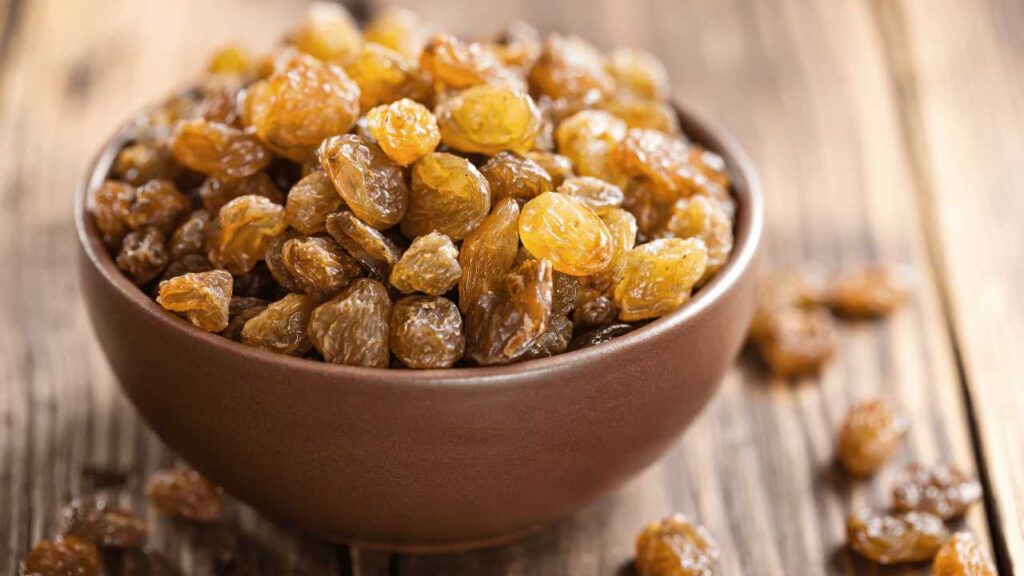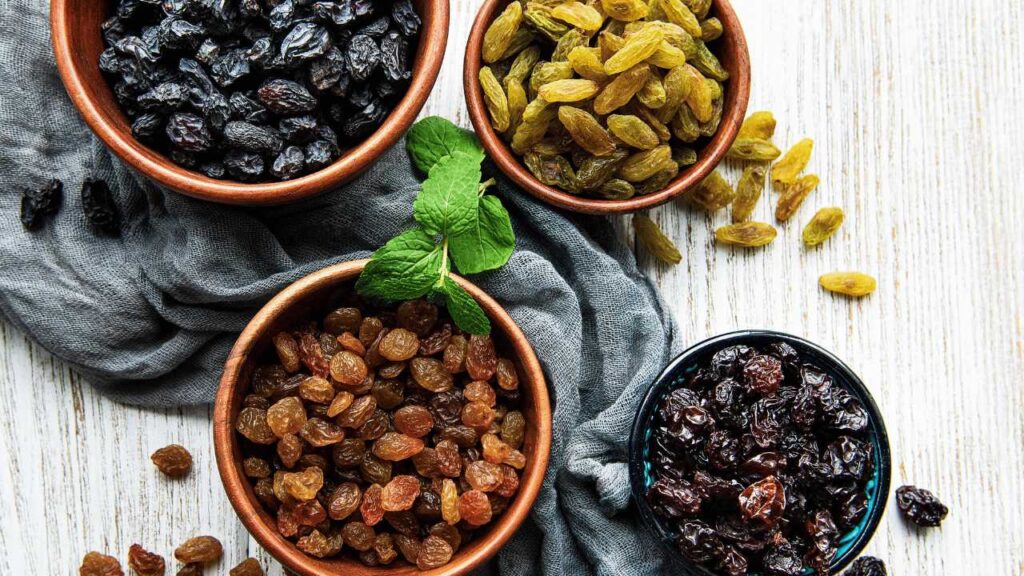Dried Raisins
Raisins are dried grapes. They are made by drying grapes until they become shriveled and have a sweet and chewy texture. Dried Raisins can be enjoyed as a snack on their own, added to baked goods like cookies and bread, or used in savory dishes like salads or rice pilaf. They are a popular ingredient in many cuisines around the world. Raisins are naturally sweet and provide a good source of energy, fiber, and various vitamins and minerals. They are a great option when you’re looking for a convenient and nutritious snack.

How Raisin Make?
Dried Raisins grow from grapes, just like the ones you eat fresh. The process of making raisins involves drying grapes in the sun or through artificial means. When grapes are left to dry, either on the vine or after they are harvested, they lose moisture and become raisins. The drying process concentrates the natural sugars in the grapes, resulting in the sweet and chewy texture of raisins. It takes time and specific conditions for the grapes to transform into raisins. After they are dried, the raisins are sorted, cleaned, and packaged for consumption. It’s fascinating how something as simple as drying grapes can create such a delicious and versatile snack.

Cultivation of Raisins
Raisins are grown in several countries around the world. Some of the major producers of raisins include the United States, Turkey, Iran, and Greece. The United States, particularly California, is known for its abundant production of raisins. Turkey is also a significant producer, known for its variety of raisin types. Iran and Greece have a long history of cultivating grapes and producing high-quality raisins. Other countries like Australia, South Africa, and Chile also contribute to the global production of raisins. The specific climate and growing conditions in these regions make them ideal for grape cultivation and raisin production. It’s fascinating to see how raisins are grown in different parts of the world.
Types Of Risins
There are several types of raisins. Here are some popular ones:
- Thompson Seedless: These are the most common and widely available raisins. They have a light color and a sweet flavor.
- Sultanas: Sultanas are made from seedless green grapes and are lighter in color and sweeter in taste compared to other raisin varieties.
- Golden Raisins: These raisins are made from yellow or golden-colored grapes. They have a milder and slightly tangy flavor.
- Black Raisins: Black raisins are made from darker-colored grapes and have a richer and more intense flavor.
- Muscat Raisins: Muscat raisins are made from muscat grapes, which have a distinct floral aroma and a sweeter taste.
These are just a few examples, and there are many more types of raisins available. Each type has its own unique flavor and characteristics.

Benefits Of Raisins
Dried Raisins have several benefits. They are a nutrient-dense snack that offers a variety of health benefits. Here are a few:
- Rich in Fiber: Raisins are a good source of dietary fiber, which helps promote healthy digestion and can aid in preventing constipation.
- Natural Energy Boost: Raisins are packed with natural sugars like fructose and glucose, providing a quick and natural energy boost when you need it.
- Antioxidant Power: Raisins contain antioxidants like polyphenols, which help protect against cell damage caused by harmful free radicals.
- Vitamins and Minerals: Raisins are a good source of vitamins and minerals, including potassium, iron, and B vitamins.
- Heart Health: The fiber, antioxidants, and potassium in raisins contribute to heart health by helping to lower blood pressure and reduce the risk of heart disease.
Dishes Of Raisins
There are various delicious dishes that incorporate raisins. Let me give you some examples:
- Raisin Bread: You can add raisins to bread dough to create a sweet and fruity twist on traditional bread.
- Rice Pilaf: Raisins can be included in rice pilaf to add a touch of sweetness and texture.
- Couscous Salad: A common ingredient in couscous salads, raisins add a burst of sweetness to the dish.
- Raisin Oatmeal Cookies: Raisins are a classic addition to oatmeal cookies, providing a chewy and sweet element.
- Moroccan Tagine: Raisins are a frequent ingredient in Moroccan tagines, adding a sweet and tangy flavor to the slow-cooked dish.
These are just some examples, but there are countless ways to incorporate raisins into dishes.
Side Effects Of Raisins
While dried raisins are generally safe to consume, it’s important to be aware of potential side effects:
- Allergic Reactions: Some individuals may be allergic to raisins, particularly if they have an allergy to grapes or dried fruits. If you have a known allergy, it’s best to avoid raisins.
- Digestive Issues: Raisins are high in fiber, which can cause digestive discomfort like bloating or gas if consumed in large quantities. It’s important to consume them in moderation and drink plenty of water to aid digestion.
- Tooth Decay: Raisins are naturally sweet and sticky, so they can contribute to tooth decay if proper oral hygiene is not maintained. Be sure to brush your teeth after consuming raisins or any sugary foods.
It’s always wise to listen to your body and consume foods in moderation. If you have any concerns or specific health conditions, it’s best to consult with a healthcare professional.